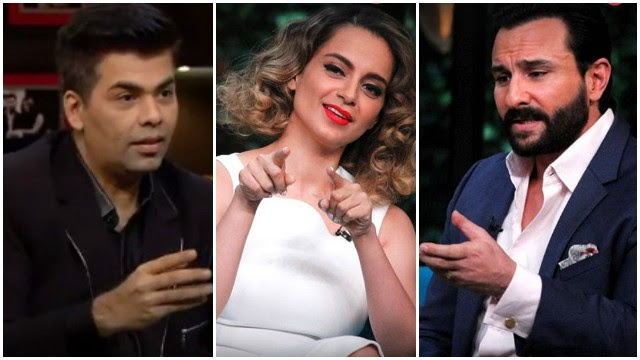A lot has been said and a lot has been written about the ‘nepotism’ in Bollywood since actress Kangana Ranaut accused film maker Karan Johar, in the latter’s own popular TV show, as “the flag bearer of Nepotism.” The debate resurfaced again after a lame attempt at a joke at the IIFA Awards landed filmmaker Karan Johar and actors Saif Ali Khan and Varun Dhawan in a social media mess.
However I want look at the problem of “Bollywood’s nepotism” in light of a very ancient problem of South Asia: the caste system.
First, let’s look at the snapshot of how caste system may have evolved in India and Nepal:
Nobody knows for sure when, how and why exactly the caste system that we find in India and Nepal today originated. The hypothesis is that the caste system was started as a division of society based on labor: the occupation. Caste system is a complex social dynamic among Hindus, comprised of Jaati and Varna.
According to Vedic period literature, Jaati means a classification based on the way sentient beings are born. Naya-Sutra states “Samaanaprasavaatmika Jaati” or those having similar birth source form a Jaati. The Shastras (Hindu holy-books) say Jaati is creation of Brahmaan (the creator-god or can also mean entire universe).
All beings in the universe are classified into four Jaatis:
1) Udbhija: sprouted from earth like plants, trees, vegetables etc.
2) Andaja: born out of egg like fish, bird, snakes, dinosaur etc.
3) Jarayuja or Pindaja: born out of physical body like mammals, animals, humans etc.
4) Ushmaja or Swedaja: reproduced due to ambient condition and temperature like insects, bacteria and viruses.
Now lets look at the word Varna: varna means one that is adopted by choice. While Jaati is provided by God (or by Universe or by the nature), Varna is our choice (or “free will” perhaps). There are four major varnas:
Shudras (Artisans and Skilled Workers) are the service providing people to the rest of the society.
Vaishyas (Farmers, Merchants, and Business People) are the productive class of the people.
Kshatriyas (Warriors, Police, and Administrators) are the nobility, the protectors of society.
Brahmanas (Priests, Teachers, and Intellectuals) who provide education and spiritual leadership.
In modern-world-term, if we try to fit these ancient class system then the planners, thinkers and educators are the Brahmanas; strategists, executors and people working with all kinds of security agencies are Kshatriyas; people who make sure all the distribution of labor and goods through trades and commerce are Vaishyas and the people providing all kinds of services can be classified as Shudras.
If we understand the caste system like this, then I have become all of these four caste-classification during my lifetime, sometimes becoming Brahmana and Shudra at the same time and so on. The Varna, originally, was not fixed based up on familial-lineage rather, for a healthy society, it definitely was and should be flexible; in other word: freedom to choose one’s profession or occupation was allowed. There might have been other reasons how caste became fixed heritage and legacy for some and curse for others, but one thing is sure that “the nepotism” must have played a big role to turn the flexible Varna-byabastha (caste-system) into fixed family lineage. Thus, eventually, caste-system became an invisible monster to lock Sudras (the service providers) into Dalit (untouchables) and Brahmins never give up being Brahmin (co-called higher caste). Thus, individuals of the society who, perhaps, were free to choose their own occupation, and change if they wished later in the life, according to their own traits and interests or retired all together due to the age factor or health conditions, were stuck to adopt the occupation whatever their previous generations did for living.
After nepotism was embedded into the caste system and it was now fixed into family lineage, several books such as Manusmriti came into play to govern this caste system through Heredity, Caste Rules, Marriage, State Support and creating one of the ugliest things that humankind ever experienced. For example, making it impossible for Sudras (primarily service givers but considered untouchables later on) to become the thinkers and planners (primary jobs of Brahmins) and vice versa; impossible for Vaishyas (the accountants and traders) to become the Chetriyas (the strategists, executors, governors and security personals) and vice versa. Further divisions were added based on gender and color of the skin and dedicated festivals, rituals, food they ate, clothes they wear, natural resources they are allowed or not allowed to collect, marriage, sex and sexuality etc., were mandated based on this caste system.
The primary reason must have been the fact that the families in ancient times (like today’s most of the families) wanted their Knowledge/ideas (Bramhanism), wealth (Vaishyaism)and power(Chetriyaism) to be kept inside their families only; the skill, hard-work and service (Sudraism) gets sidelined. Similarly, Bollywood’s big players seem to operate believing that keeping money inside the family is the best way to protect material-intellectual-emotional assets and also keep the next generation in check.
But one thing the caste system remarkably failed and still failing is, to stop people abandoning caste system altogether to become a hermit, no matter what caste they were born or belonged.
While Bollywood may or may not develop their own “book of nepotism” to govern it; yet through unwritten yet thriving rules like heredity, pay-rules, Bollywood-dynastic-support-system, the nepotism is already well governed in Bollywood. So the question is: will the “occupation of acting” in a Bollywood movie be added as the fifth caste to Indian ancient caste system? Or has it already?
Or will Bollywood manage to liberate itself from nepotism and be inspired to abolish the rigid-caste-system of India. Can Bollywood let people choose their occupation/profession as they wish without prejudice, heredity, caste-rules, marriage and religious institution’s interference?
- JK Rowling and Trans Debate is Driven by Western Perspectives - August 10, 2020
- Development crisis: Humans are the problem, Human must be the solution - September 13, 2017
- Marry a Feminine-Nature and a Masculine-Energy Before You Can Marry a Man - August 30, 2017

